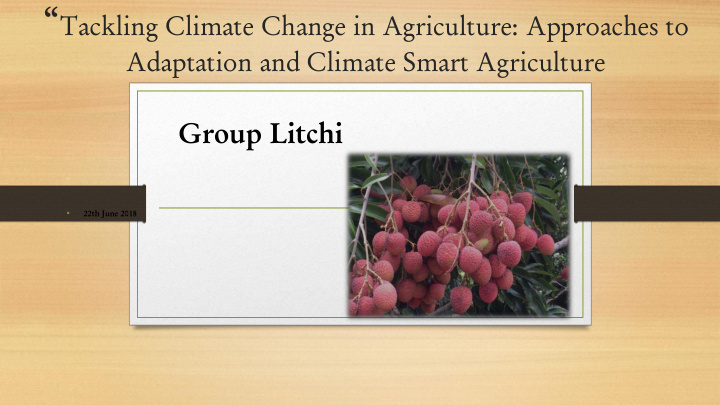



“ Tackling Climate Change in Agriculture: Approaches to Adaptation and Climate Smart Agriculture Group Litchi • 22th June 2018
System of Interest Litchi Orchard Management at Calebasse in the North 22th June 2018
Sustainable Development Goal • To increase productivity and income over a period of five years
Litchi Production in Mauritius • Litchi first reported in Mauritius in 1763 • Litchi introduced during the French colony (1715-1810) from China • In 1929, during the British colony, varieties Sun Yat Sen,Green, Rose scented and Kafri were brought from India • First litchi export to London in 1934 till 1939 • Export of litchi gain economic importance as from 1969 • From 1984 to 1990, 120 tonnes of litchi were exported annually • After 1990 the export continued to rise
• Main variety - Tai So • 346 litchi orchards covering a total area of 423 ha • Fruit harvest season – early Nov. to early Jan. • Export market: 250 to 300 tonnes annually • Premium price for early season litchi • Shift from backyard to intensive system of production over last decade • Potential for regular bearing instead of every 2 yrs – through timely pruning, fertilization and irrigation • 2017 ----- 70%
Climate Hazards the System might be exposed to • Cyclone • Heavy rainfall • Drought / extended dry spells • High temperature • Erratic rainfall
Adaptation Measures POLICY • Soft loans • Freight rebate scheme (FRS) • MauriGap certification • Development of a supply chain for processed litchi products • Agricultural risk insurance
How do policy measures answer our goal? • Policy measures will provide the necessary financial support (compensation and incentives) to help growers of the cooperative to face extreme climatic events (e.g FRS) • MauriGap: Guarantee - Safe food and fetching premium litchi price i.e. higher grower income • Processing - Added value of litchi products for higher income and extended product availability to consumers
Adaptation Measures TECHNICAL • Technical information dissemination (media, publication, SMS disease alert, Meteo, APMIS) • Pest and Disease Management • Timely fertilizer application
How do technical measures answer our goal? • Early warning system will contribute to decision making • Proper cultural practices, including timely fertilization will ensure annual fruit bearing and therefore contribute to sustained productivity
Adaptation Measures RESEARCH • Introduction of new varieties • Extend the shelf-life for export • Decrease post-harvest losses
How do research measures answer our goal? • Introduction of early varieties to avoid the cyclonic season/heavy rainfall for a resilient system • Tolerance of varieties to high temperature, pest & disease for a greater fruit yield and revenue • Eco-friendly technology to extend the shelf-life of litchi products and extend period for product marketing
Adaptation Measures CAPACITY BUILDING • Water management • Tree management • Agro-processing • Setting up of a model farm • Flower induction techniques
How do capacity building measures answer our goal? • Empower growers to improve flowering, fruit set, and quality product • Improve water use and fertilizer efficiency • Create opportunity for value addition through processing • Increase grower awareness about new production practices and increase production skills
Mitigation Potential • Reduction in GHG through: 1. The judicious use of fertilizers, and pesticides (IPM) 2. Mulching, 3. Increase in the carbon sink capacity (healthy canopy development),
“ Tackling Climate Change in Agriculture: Approaches to Adaptation and Climate Smart Agriculture Litchi Group • Keshav • Patricia • Satish • Yogeeta • Giantee • Rajiv 22th June 2018 Thank you for your attention!
Recommend
More recommend